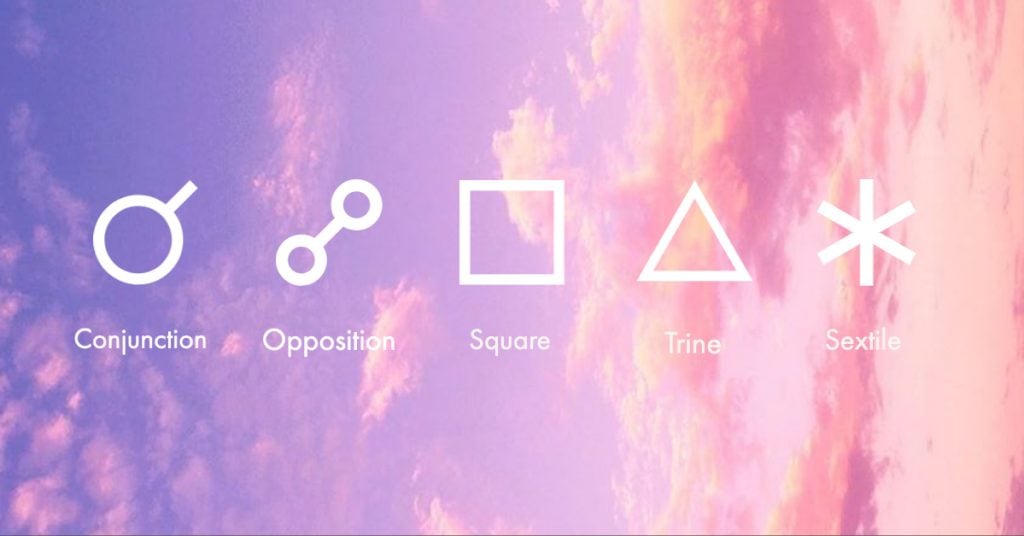Astrology Aspects
Do you have a sun-moon conjunction in your birth chart that makes you capable of accomplishing great things in life? Did today’s horoscope warn you of a moon-Jupiter opposition that could make you lose control and turn your whole world upside down? Conjunctions and oppositions are “aspects” in astrology, and they simply denote the degree of distance between planets or points in the zodiac. The distance between planets or points is what creates an aspect.

Aspects are calculated by using certain divisions of the 360-degree zodiac wheel to establish interactions between the planets. Not all degree distances are always as relevant. In astrology, orbs are the distance of degrees that planets are from one another. For example, if you have a Scorpio sun at 10 degrees and a Scorpio Venus at 9 degrees, these two planets form a conjunction.
What Are the Most Common Aspects in Astrology?
- Conjunction (0-10 degrees)
- Opposite (180 degrees)
- Square (90 degrees)
- Trine (120 degrees)
- Sextile (60 degrees)
These five aspects are broken up into what are called “soft” (easy) aspects (conjunct, sextile and trine) and “hard” or (difficult) aspects (square and opposition). The energy the aspect brings reveals how the planets will interact with each other. Taking a closer look at the angular relationships between planets sheds light on how that particular aspect or interaction will manifest and what type of energy it will produce.
Confused? An easy way to think about aspects is this: When a planet moves through a specific sign (i.e. Mercury enters the zodiac sign of Pisces), it “dresses up” in that sign. It “wears” that zodiac sign’s characteristics, but in general it’s a passive interaction. However, when two planets are in aspect with one another, there is a much more energized and motivational quality involved.
To get a better idea of what each aspect entails, here are more detailed descriptions of the five major aspects:
Conjunction
- A conjunction forms when two planets are 0-10 degrees apart in the birth chart. In general, astrologers like to use the tightest orb as possible, a 5-degree orb is preferred. They are traveling close together in the same zodiac sign. A conjunction is a blending of the two planets’ energies, which can be an extremely powerful alliance—or too much of a good thing, depending on the planets involved. Imagine if you’re born with both your sun and Mercury in Cancer. If they’re sitting right next to one another in your birth chart, that’s a conjunction. A conjunction is like your first romantic relationship—when it was good it was amazing, but when it was bad, ugh. Most conjunctions are good for combining the planets’ energies and using them in a positive way. Although when two planets meet up and become too much of a good thing, the resulting energy can cause restlessness, distraction, or tension.
Opposition
- An opposition forms when two planets are 180 degrees apart. Because the planets are opposite each other, the energy manifests as a polarity. This energy calls for more balance than disruption. When two planets are as far apart as they can get, it can cause dramatic tension. It can also be extremely powerful. If the person learns to add balance and negotiate between both planets’ energies, then success can come. Oppositions are like frenemies. Although there is the potential for an adversarial relationship, there is also real opportunity for growth and conflict resolution. It’s important that these two opposing forces learn to listen to each other and agree to play on their strengths, rather than exploiting each other’s weaknesses.
Trine
- A trine forms when two planets are 120 degrees apart. This aspect creates the highest point of synchronicity. An easy way to remember this is that signs of the same element all form trines to one another. For example, Aries, Leo, and Sagittarius are all fire signs and all form this angle. It is a harmonious, lucky and easy position for two planets to interact. Because these planets will be in the same element, they are on the same page when working toward goals. Sometimes, a trine is like two parents who are willing to do anything to make their child happy. Both planets have the same energy and agenda, and are ready to work together to form the best possible outcome for any situation. But too much of a good thing, or too many “yes” can cause its own set of negative issues. The lack of challenge can cause individuals to be complacent and the easy-going energy can actually manifest as counterintuitive. Overall, trines can reveal positive aspects of opportunity.
Square
- A square forms when two planets are 90 degrees apart. The resulting energy can be quite difficult and represents a tug-of-war type of relationship. The tension, conflict and power struggles caused by a square is reminiscent of getting ready for battle. Each side digs in its heels and resists compromise. Yet in order to resolve the stress and pressure, each planet must be willing to meet in the middle. A square is like a contentious custody battle. Because of this tense, stubborn energy, squares aren’t a good time to make major decisions. Instead, weigh the pros and cons of the situation and be willing to negotiate the best possible outcome. In the birth chart, squares can actually cause us to take action. The tension and challenging energy asks us to evolve and is actually beneficial for creating inner drive.
Sextile
- A sextile forms when two planets are 60 degrees apart. A sextile is a compatible relationship between two planets, but it isn’t the strongest out there. When two planets form a sextile the interaction positive, and there should be little conflict. But there’s also not a lot of helpful energy either. Sextiles are good for resoling low-level conflicts and taking a laid-back approach to topics that might otherwise be controversial.